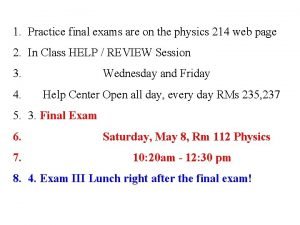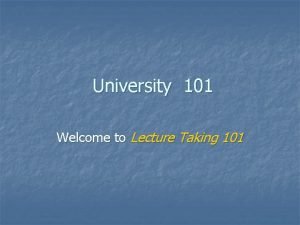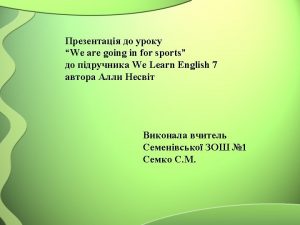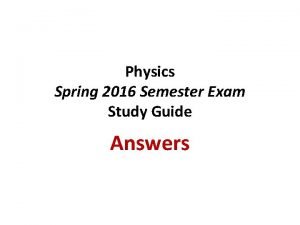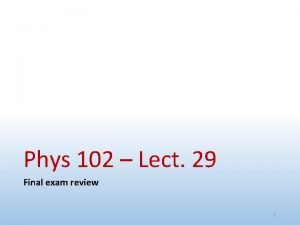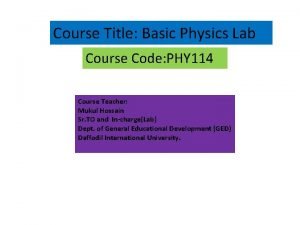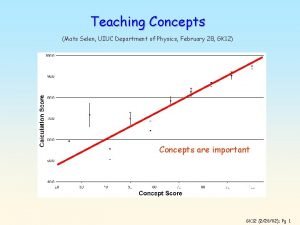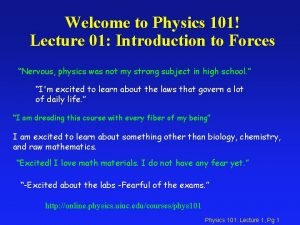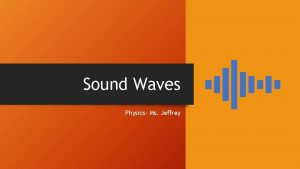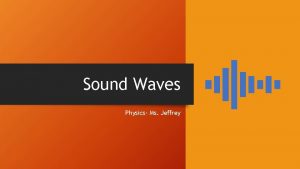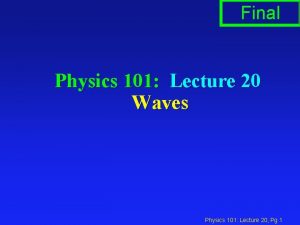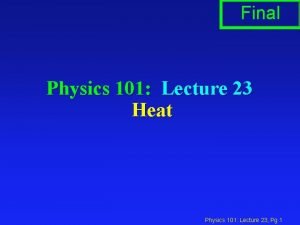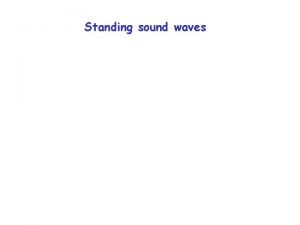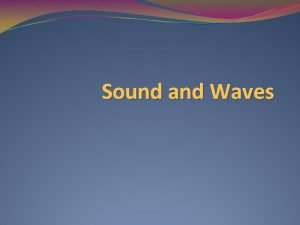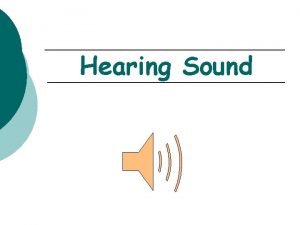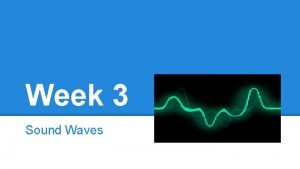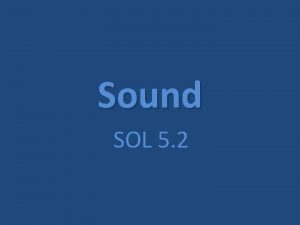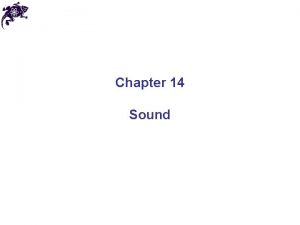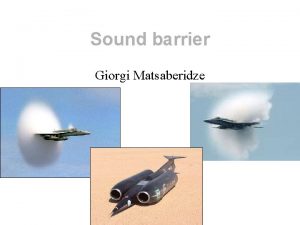Final Physics 101 Lecture 21 Sound Physics 101



















- Slides: 19

Final Physics 101: Lecture 21 Sound Physics 101: Lecture 21, Pg 1

Speed of Sound for pulse on string: v = sqrt(F / m) l For fluids: v = sqrt(B/r) l Recall Medium Speed (m/s) Air 343 Helium 972 Water 1500 Steel 5600 Physics 101: Lecture 21, Pg 2 05

Velocity Question A sound wave having frequency f 0, speed v 0 and wavelength 0, is traveling through air when in encounters a large helium-filled balloon. Inside the balloon the frequency of the wave is f 1, its speed is v 1, and its wavelength is 1 Compare the speed of the sound wave inside and outside the balloon 1. v 1 < v 0 2. v 1 = v 0 3. v 1 > v 0 V 0=343 m/s V 1=965 m/s Physics 101: Lecture 21, Pg 3 10

Frequency Question A sound wave having frequency f 0, speed v 0 and wavelength 0, is traveling through air when in encounters a large helium-filled balloon. Inside the balloon the frequency of the wave is f 1, its speed is v 1, and its wavelength is 1 Compare the frequency of the sound wave inside and outside the balloon 1. f 1 < f 0 2. f 1 = f 0 3. f 1 > f 0 f 1 Time between wave peaks does not change! Physics 101: Lecture 21, Pg 4 13

Wavelength Question A sound wave having frequency f 0, speed v 0 and wavelength 0, is traveling through air when in encounters a large helium-filled balloon. Inside the balloon the frequency of the wave is f 1, its speed is v 1, and its wavelength is 1 Compare the wavelength of the sound wave inside and outside the balloon 1. 1 < 0 2. 1 = 0 1 0 3. 1 > 0 =v/f Physics 101: Lecture 21, Pg 5 15

Standing Waves in Pipes Open at both ends: Pressure Node at end = 2 L / n n=1, 2, 3. . Open at one end: Pressure Anti. Node at closed end : = 4 L / n n odd Physics 101: Lecture 21, Pg 6 29

Example: Organ Pipe A 0. 9 m organ pipe (open at both ends) is measured to have it’s first harmonic at a frequency of 382 Hz. What is the speed of sound in the pipe? Physics 101: Lecture 21, Pg 7 32

Superposition & Interference l Consider two harmonic waves A and B meeting at x=0. èSame amplitudes, but 2 = 1. 15 x 1. l The displacement versus time for each is shown below: A( 1 t) B( 2 t) What does C(t) = A(t) + B(t) look like? ? Physics 101: Lecture 21, Pg 8 46

Superposition & Interference l Consider two harmonic waves A and B meeting at x=0. èSame amplitudes, but 2 = 1. 15 x 1. l The displacement versus time for each is shown below: A( 1 t) B( 2 t) C(t) = A(t) + B(t) DESTRUCTIVE INTERFERENCE CONSTRUCTIVE INTERFERENCE Physics 101: Lecture 21, Pg 9 47

Doppler shift l As a police car passes you with its siren on, the frequency of the sound you hear from its siren Doppler Example Audio Doppler Example Visual 1) Increases 2) Decreases 3) Same Physics 101: Lecture 21, Pg 10 36

Doppler Effect moving source vs l When source is coming toward you (vs > 0) èDistance between waves decreases èFrequency increases l When source is going away from you (vs < 0) èDistance between waves increases èFrequency decreases l fo = fs / (1 - vs/v) Physics 101: Lecture 21, Pg 11 38

Doppler Effect moving observer (vo) l When moving toward source (vo < 0) èTime between waves peaks decreases èFrequency increases l When away from source (vo > 0) èTime between waves peaks increases èFrequency decreases l fo = fs (1 - vo/v) Combine: fo = fs (1 -vo/v) / (1 -vs/v) Physics 101: Lecture 21, Pg 12 40

Example: police car A police car is approaching you from behind so you pull over to the side of the road and stop. If the police car is moving at 25 m/s and the siren is emitting a sound with frequency 200 Hz. What frequency do you hear? Speed of sound = 330 m/s Physics 101: Lecture 21, Pg 13 44

Example: police car If the police car is moving at 25 m/s and the siren is emitting a sound with frequency 200 Hz. After the police car passes you what frequency do you hear? Speed of sound = 330 m/s Physics 101: Lecture 21, Pg 14 44

Intensity and Loudness l Intensity is the èI = P / A èUnits: Watts/m 2 l For power per unit area. Sound Waves èI = p 02 / (2 r v) (po is the pressure amplitude) èProportional to p 02 (note: Energy goes as A 2) l Loudness (Decibels) èLoudness perception is logarithmic èThreshold for hearing I 0 = 10 -12 W/m 2 èb = (10 d. B) log 10 ( I / I 0) èb 2 – b 1 = (10 d. B) log 10(I 2/I 1) Physics 101: Lecture 21, Pg 15 18

Log 10 Review l Log 10(1) = l Log 10(100) = l Log 10(1, 000) = l Log 10(10, 000, 000) = Physics 101: Lecture 21, Pg 16 19

Decibels Question l If 1 person can shout with loudness 50 d. B. How loud will it be when 100 people shout? 1) 52 d. B 2) 70 d. B 3) 150 d. B Physics 101: Lecture 21, Pg 17 22

Intensity Question l Recall Intensity = P/A. If you are standing 6 meters from a speaker, and you walk towards it until you are 3 meters away, by what factor has the intensity of the sound increased? 1) 2 2) 4 3) 8 Speaker radiating power P I 1 = P/(4 p. D 12) D 1 Area goes as d 2 so if you are ½ the distance the intensity will increase by a factor of 4 I 2 = P/(4 p. D 22) D 2 Physics 101: Lecture 21, Pg 18 27

Summary l Speed of sound v = sqrt(B/r) l Intensity B = (10 d. B) log 10 ( I / I 0) l Standing Waves èfn = n v/(2 L) èfn = n v/(4 L) Open at both ends n=1, 2, 3… Open at one end n=1, 3, 5… l Doppler Effect fo = fs (v-vo) / (v-vs) l Beats Physics 101: Lecture 21, Pg 19 50
 Physics 101 lecture notes pdf
Physics 101 lecture notes pdf Phy101 lecture 1
Phy101 lecture 1 Physics 101 lecture notes pdf
Physics 101 lecture notes pdf Waves notes pdf download
Waves notes pdf download Physics 101 final exam
Physics 101 final exam 01:640:244 lecture notes - lecture 15: plat, idah, farad
01:640:244 lecture notes - lecture 15: plat, idah, farad Articulators
Articulators Lecture sound systems
Lecture sound systems Lecture 101
Lecture 101 “a sound mind is in a sound body”
“a sound mind is in a sound body” Sound waves graphic organizer
Sound waves graphic organizer Wipo dl 101
Wipo dl 101 Physics 111 lecture notes
Physics 111 lecture notes Atmospheric physics lecture notes
Atmospheric physics lecture notes Physics semester 1 final exam study guide answers
Physics semester 1 final exam study guide answers Physics 20 final exam practice
Physics 20 final exam practice Physics 102 final exam
Physics 102 final exam Blc diu
Blc diu Uiuc physics 101
Uiuc physics 101 Phys 101 uiuc
Phys 101 uiuc




